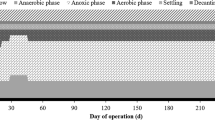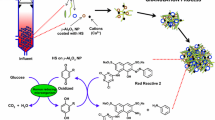Abstract
Uranium extraction and regeneration of ion exchange resin generates concentrated nitrate effluents (typically 500 to 10,000 ppm NO3–N) that are highly alkaline in nature (pH 9.0 to 11.0). It is difficult to remove nitrate from such solutions using standard physiochemical and biological methods. This paper reports denitrification of such wastes using preadapted sludge (biomass), which was acclimatized to different influent pH (7.5 to 11.5) in a sequencing batch reactor (4 l) for 2 months. Performance of the developed consortia was studied under different pH (7.5 to 12). Biomass denitrified the synthetic wastewater containing 1,694 ppm NO3–N at a pH of 10.5. Decrease in nitrite build up was observed at higher pH, which differs from the reported results. Kinetic analysis of the data showed that specific rate of nitrate reduction was highest (78 mg NO3–N/g MLSS/h) at higher pH (10.5). This was attributed to the acclimatization process. Thus, high-strength nitrate wastewater, which was highly alkaline, was successfully treated using preadapted sludge.




Similar content being viewed by others
Abbreviations
- K N :
-
Zero-order rate constant for nitrite–N loss, mg N/l/h
- \(K_{{\text{NO}}_{\text{2}} } \) :
-
Zero-order rate constant for nitrite reduction, mg NO2–N/l/h
- \(K_{{\text{NO}}_{\text{3}} } \) :
-
Zero-order rate constant for nitrate reduction, mg NO3–N/l/h
- \(k_{{\text{NO}}_{\text{2}} } \) :
-
Zero-order rate constant for actual nitrite formation, mg NO2–N/l/h
- K’N :
-
Specific rate of nitrite–N loss, mg N/g MLSS/h
- \(K{\text{'}}_{{\text{NO}}_{\text{3}} } \) :
-
Specific rate of nitrate reduction, mg NO3–N/g MLSS/h
- \(K'_{{\text{NO}}_{\text{2}} } \) :
-
Specific rate of nitrite reduction, mg NO2–N/g MLSS/h
- \(k'_{{\text{NO}}_{\text{2}} } \) :
-
Specific rate of nitrite formation, mg NO2–N/g MLSS/h
- RR:
-
Relative rate of nitrate reduction to nitrite reduction in presence of nitrate
- X :
-
Biomass concentration (MLSS), g/l
References
Glass, C., & Silverstien, J. (1999). Water Research, 33, 223–229.
Glass, C., & Silverstein, J. (1998). Water Research, 32, 831–839.
Pitt, W. W., Hancher, C. W., & Patton, B. D. (1981). Nuclear & Chemical Waste Management, 2, 57–70.
Shrimali, M., & Singh, K. (2001). Environnement & Pollution, 112, 351–359.
Thomsen, J., Geest, T., & Cox, R. P. (1994). Applied and Environmental Microbiology, 60, 536–541.
Peyton, B. M., Mormile, M. R., & Petersen, J. N. (2001). Water Research, 35, 4237–4242.
Van der Hoek, J. P., Latour, P. J. M., & Klapwijk, A. (1987). Applied and Environmental Microbiology, 27, 199–205.
Meijer, E. M., Van Der Zwaan, J., Wever, R., & Stouthamer, A. (1979). European Journal of Biochemistry, 96, 69–76.
Betlach, M. R., & Tiedje, J. M. (1981). Applied and Environmental Microbiology, 42, 1074–1084.
Dhamole, P. B., Nair, R. R., D’Souza, S. F., & Lele, S. S. (2007). Bioresource Technology, 98, 247–252.
Nair, R. R., Dhamole, P. B., Lele, S. S., & D’Souza, S. F. (2007). Chemosphere, 97, 1612–1617.
APHA, AWWA. WEF (1992). Washington DC: APHA.
Moore, S., & Schroeder, E. (1971). Water Research, 5, 445–452.
Acknowledgements
We thank Department of Atomic Energy, India for funding this work and Rashtriya Chemicals and Fertilizers, Mumbai, India for providing the sludge.
Author information
Authors and Affiliations
Corresponding author
Rights and permissions
About this article
Cite this article
Dhamole, P.B., Nair, R.R., D’Souza, S.F. et al. Denitrification of Highly Alkaline Nitrate Waste Using Adapted Sludge. Appl Biochem Biotechnol 151, 433–440 (2008). https://doi.org/10.1007/s12010-008-8211-6
Received:
Accepted:
Published:
Issue Date:
DOI: https://doi.org/10.1007/s12010-008-8211-6




